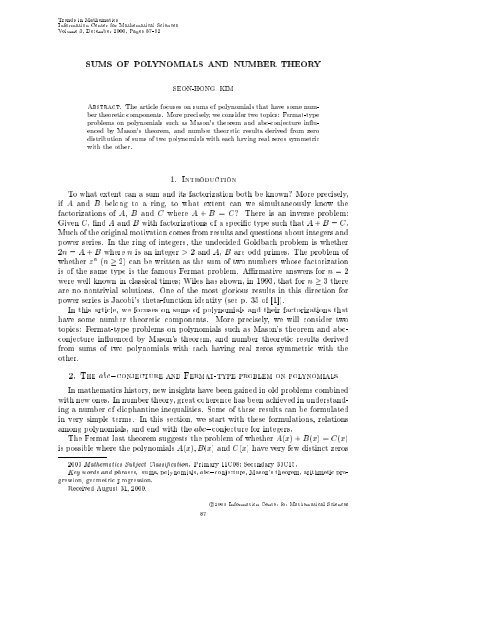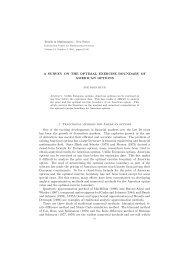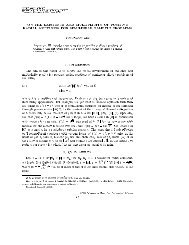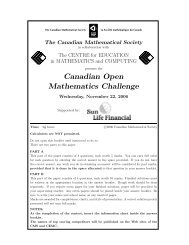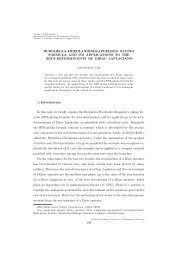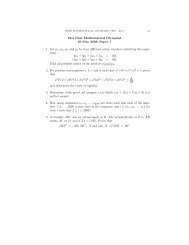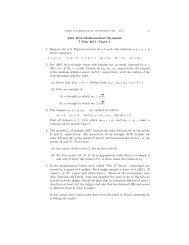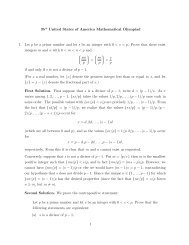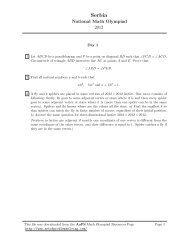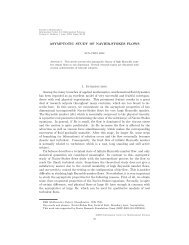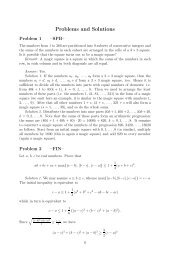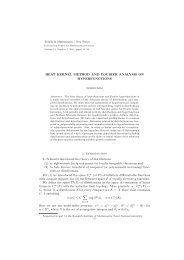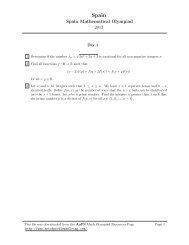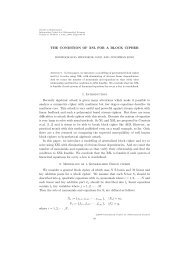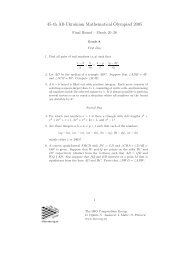SUMS OF POLYNOMIALS AND NUMBER THEORY 1. Introduction 2 ...
SUMS OF POLYNOMIALS AND NUMBER THEORY 1. Introduction 2 ...
SUMS OF POLYNOMIALS AND NUMBER THEORY 1. Introduction 2 ...
Create successful ePaper yourself
Turn your PDF publications into a flip-book with our unique Google optimized e-Paper software.
Trends in Mathematics<br />
Information Center for Mathematical Sciences<br />
Volume 3, December 2000, Pages 87{92<br />
<strong>SUMS</strong> <strong>OF</strong> <strong>POLYNOMIALS</strong> <strong>AND</strong> <strong>NUMBER</strong> <strong>THEORY</strong><br />
SEON-HONG KIM<br />
Abstract. The article focuses on sums of polynomials that have somenumber<br />
theoretic components. More precisely, we consider two topics: Fermat-type<br />
problems on polynomials such as Mason's theorem and abc-conjecture inuenced<br />
by Mason's theorem, and number theoretic results derived from zero<br />
distribution of sums of two polynomials with each having real zeros symmetric<br />
with the other.<br />
<strong>1.</strong> <strong>Introduction</strong><br />
To what extent can a sum and its factorization both be known More precisely,<br />
if A and B belong to a ring, to what extent can we simultaneously know the<br />
factorizations of A, B and C where A + B = C There is an inverse problem:<br />
Given C, ndA and B with factorizations of a specic type such thatA + B = C.<br />
Much of the original motivation comes from results and questions about integers and<br />
power series. In the ring of integers, the undecided Goldbach problem is whether<br />
2n = A + B where n is an integer > 2andA, B are odd primes. The problem of<br />
whether z n (n 2) can be written as the sum of two numbers whose factorization<br />
is of the same type is the famous Fermat problem. Armative answers for n =2<br />
were well known in classical times Wiles has shown, in 1993, that for n 3 there<br />
are no nontrivial solutions. One of the most glorious results in this direction for<br />
power series is Jacobi's theta-function identity (seep.35 of [1]).<br />
In this article, we focuses on sums of polynomials and their factorizations that<br />
have some number theoretic components. More precisely, we will consider two<br />
topics: Fermat-type problems on polynomials such as Mason's theorem and abcconjecture<br />
inuenced by Mason's theorem, and number theoretic results derived<br />
from sums of two polynomials with each having real zeros symmetric with the<br />
other.<br />
2. The abc;conjecture and Fermat-type problem on polynomials<br />
In mathematics history, new insights have been gained in old problems combined<br />
with new ones. In number theory, great coherence has been achieved in understanding<br />
a number of diophantine inequalities. Some of these results can be formulated<br />
in very simple terms. In this section, we start with these formulations, relations<br />
among polynomials, and end with the abc;conjecture for integers.<br />
The Fermat last theorem suggests the problem of whether A(x)+B(x) =C(x)<br />
is possible where the polynomials A(x)B(x) andC(x) have very few distinct zeros<br />
2000 Mathematics Subject Classication. Primary 11C08 Secondary 30C15.<br />
Key words and phrases. sums, polynomials, abc;conjecture, Mason's theorem, arithmetic progression,<br />
geometric progression.<br />
Received August 31, 2000.<br />
87<br />
c2000 Information Center for Mathematical Sciences
88 SEON-HONG KIM<br />
and deg A(x) = deg B(x) = deg C(x). Here Mason's ABC polynomial theorem<br />
(see [11]) gives a negative result. In 1981, Stothers [17] proved a theorem on polynomials,<br />
which did not attract too much attention until 1983, when Mason [14]<br />
started a new trend of thought about polynomials by discovering the same theorem.<br />
In 1998, Snyder gave hisown version of proof for this theorem when he was<br />
still a high school student.<br />
Theorem 2.<strong>1.</strong> (Stothers-Mason-Snyder) Let m(P )=m(P (x)) be the number<br />
of distinct zeros of a polynomial P (x). Let<br />
A + B = C<br />
where A B and C are relatively prime polynomials. Then<br />
max deg(A B C) m(ABC) ; 1:<br />
The cases of equality in Mason's ABC polynomial theorem are linked to numerous<br />
results in number theory triple of integers generated by these cases lead, by<br />
using the abc;conjecture, to optimal minoration of Q(G(A B)) (where G 2 Z[X T]<br />
is a form, A B are relatively prime integers, and Q(k) denotes the product of the<br />
distinct primes dividing k) in these polynomial constructions of integers, the role<br />
of the Mason's theorem is crucial (See [12], [13]). A new identity (see [10]) that<br />
shows a case of equality (related to Chebyshev polynomials) in Mason's theorem is<br />
x 2k =<br />
2 2<br />
x k i<br />
T k +(x<br />
x 2 +1) x k;1 i<br />
U k;1 <br />
x<br />
where T and U denote the Chebyshev polynomials of the rst and the second,<br />
respectively. Their factorizations are of course completely known.<br />
Another Fermat-type problem on polynomials is the question of the existence of<br />
relatively prime polynomials P (x)Q(x)R(x) over the complex number eld such<br />
that for some integer n>2 [P (x)] n +[Q(x)] n =[R(x)] n . The answer, due to an<br />
application of Mason's theorem (see [11]), is that no such polynomials exist.<br />
Inuenced by Mason's theorem, Masser and Oesterle formulated the abc;conjecture<br />
for integers as follows. The well known abc;conjecture states : Given >0, there<br />
is a number C such that for any prime positive integers a, b, c with a + b = c, we<br />
have<br />
(2.1) c
<strong>SUMS</strong> <strong>OF</strong> <strong>POLYNOMIALS</strong> <strong>AND</strong> <strong>NUMBER</strong> <strong>THEORY</strong> 89<br />
[15] obtained an upper bound exp fC 1 Q(abc) 15 g for c of the type (2.1) for some<br />
absolute constant C 1 . In 1991, Stewart and Yu [16] improved the upper bound by<br />
c
90 SEON-HONG KIM<br />
arithmetic progressions in S n . We can, however, nd some geometric progressions<br />
in S 6 , S 8 and S 10 (see [8]). Some simple examples of geometric progressions in S 6<br />
arise from the identity<br />
(x ; a) 3 (x ; b) 3 +(x + a) 3 (x + b) 3 =2(u + ab)(u 2 +(3a 2 +8ab +3b 2 )u +(ab) 2 )<br />
=2Q 1 (u)Q 2 (u) u = x 2 say<br />
since the product of the zeros of Q 2 is the square of the zero of Q 1 . A further<br />
question of interest is whether both the r i and the s i can be in geometric progression.<br />
Observe the identity<br />
(x ; h)(x ; hq 2 )(x ; hq 4 )(x ; hq 6 )(x ; hq 8 )(x ; hq 10 )<br />
+(x + h)(x + hq 2 )(x + hq 4 )(x + hq 6 )(x + hq 8 )(x + hq 10 )<br />
=2(x 2 + 1)(x 2 + h 2 q 10 )(x 2 + h 4 q 20 )<br />
; 2x 2 (x 2 + h 2 q 10 )<br />
<br />
1 ; q 2 (q 4 +1) q7 ; 1<br />
q ; 1<br />
If we take q =2andh =0:5950 , a zero of<br />
2 20 h 4 ; 371348h 2 +1<br />
q 7 +1<br />
q +1 h2 + h 4 q 20 <br />
:<br />
the last factor on the right side of the identity becomes zero and we have acasein<br />
whichther i and the s i are both in geometric progression, and the r i are all distinct.<br />
An example (3.1) below is also a case in which both the r i and the s i are in geometric<br />
progression. Moreover (3.1) below is of considerable interest in connection with [9].<br />
Observe that(x ; 1) 6 +(x +1) 6 =2(x 2 + 1)(x 2 +(2; p 3) 2 )(x 2 +(2+ p 3) 2 ). Let<br />
r 1 and r 3 be the real and mutually reciprocal zeros of<br />
E m (u) :=u 2m ; u m+1 ; 2u m ; u m;1 +1=0<br />
m 2<br />
and set r 2 =<strong>1.</strong> Then we have<br />
(3.1)<br />
3Y<br />
3Y<br />
(x ; r i ) 2 + (x + r i ) 2 =2 (x 2 + ri 2m ):<br />
i=1<br />
i=1<br />
i=1<br />
Also, for j = 1 3, as m ! 1, r j ! 1 and r m j ! 2 p 3. On the other<br />
hand, Kim studied in [9] as follows. A simple equality (x ; 1) 4 +(x +1) 4 =<br />
2(x 2 +( p 2 ; 1) 2 )(x 2 +( p 2+1) 2 ) is in fact the limiting case m ! 1 of the<br />
sequence of readily veried identities<br />
(3.2)<br />
2Y<br />
2Y<br />
(x ; r i ) 2 + (x + r i ) 2 =2 (x 2 + ri 2m ) m 2<br />
i=1<br />
i=1<br />
i=1<br />
where r 1 = r m is the unique positive zeroofF m (u) :=u 2m ; u m+1 ; u m;1 ; 1, and<br />
r 2 =1=r m . As m !1,<br />
(3.3) (x ; r m ) n (x ; 1<br />
r m<br />
) n +(x + r m ) n (x + 1<br />
r m<br />
) n ! (x ; 1) 2n +(x +1) 2n :<br />
2Y<br />
3Y
<strong>SUMS</strong> <strong>OF</strong> <strong>POLYNOMIALS</strong> <strong>AND</strong> <strong>NUMBER</strong> <strong>THEORY</strong> 91<br />
Here r m ! 1andrm m ! 1+ p 2asm !<strong>1.</strong> Thus wehave a situation quite analogous<br />
to that of (3.2). The limit (3.3) motivates the introduction to new analogues<br />
<br />
n<br />
(3.4) 2<br />
k<br />
2F 1 ; k<br />
2<br />
2 ;1 2 (2n ; k) 1 2 1 ; <br />
<br />
rm + r m<br />
;1 2<br />
4<br />
; <br />
2n<br />
of 2<br />
k (k even). Kim [9] studied their minimal polynomials which ; are<br />
related to<br />
2n<br />
Chebyshev polynomials. Moreover, he showed that the analogue of 2<br />
2 is the only<br />
real zero of its minimal polynomial, and has a dierent representation, by usinga<br />
polynomial of smaller degree than F m (u). ; <br />
He also described how to compute; the<br />
2n<br />
minimal polynomial of an analogue of 2<br />
k (k>2) by using an analogue of 2 2n<br />
<br />
2 .<br />
We end up this section with following Kim's questions and conjecture in this<br />
direction. Are there geometric progressions in S n (n 10) If so, are there<br />
examples with both the r i and the ; s i in geometric progression From (3.1) we<br />
2n<br />
can derive similar analogues of 2<br />
k (k even) to (3.4) and study their minimal<br />
polynomials. Are there appropriate settings Finally we conjecture the following:<br />
Suppose r i = q i , where q>0. Let >0begiven. Then for n suciently large<br />
s m+1 <br />
; q 2 <<br />
s m<br />
for n=4 m 3n=8. Some related results to the topic of this section are also given<br />
in [6] and [7].<br />
References<br />
[1] J. M. Borwein, P. B.Borwein, Pi and the AGM, John Wiley & Sons, Inc., New York, 1998.<br />
[2] J. Browkin, M. Filaseta, G. Greaves, A. Schinzel, Squarefree values of polynomials and the<br />
abc-conjecture, Sieve Methods, Exponential Sums, and their Applications in Number Theory<br />
(G. Greaves, G. Harman, M. Huxley, eds.), Cambridge Univ. Press, Cambridge, 1997, pp. 65{<br />
85.<br />
[3] H. J. Fell, On the zeros of convex combinations of polynomials, Pacic J. Math. 89 (1980),<br />
43{50.<br />
[4] M. Filaseta, S. Konyagin, On a limit point associated with the abc-conjecture, Colloq. Math.<br />
76 (1998), 265{268.<br />
[5] G. Greaves, A. Nitaj, Some polynomial identities related to the abc-conjecture, Number Theory<br />
in Progress (K. Gyoery et al, eds.), Proceedings of the international conference organized<br />
by the Stefan Banach International Mathematical Center in honor of the 60th birthday of<br />
Andrzej Schinzel, Berlin, 1999, pp. 229{236.<br />
[6] S. H. Kim, Bad pairs of polynomial zeros, Commun. Korean Math. Soc. (to appear).<br />
[7] , Convex combinations of products of nite geometric series (preprint).<br />
[8] , Sums of two polynomials with each having real zeros symmetric with the other<br />
(preprint).<br />
[9] , The analogues of 2 ; 2n<br />
k<br />
<br />
with k even (preprint).<br />
[10] , Zeros of certain sums of two polynomials (preprint).<br />
[11] S. Lang, Old and new conjectured diophantine inequalities, Amer. Math. Bull. 23 (1990),<br />
37{50.<br />
[12] M. Langevin, Sur quelques consequences de la conjecture (abc) en arithmetique et en logique,<br />
Rocky Mount. J. of Math 26 (1996), 1031{1042.<br />
[13] , Imbrications entre le theoreme de Mason, la descente de Belyi et les dierentes<br />
formesdelaconjecture (abc), J.Theor. Nombres Bordeaux 11 (1999), 91{109.<br />
[14] R. C. Mason, Diophantine equations over functional elds, London Mathematical Society<br />
Lecture Note Series, 96, Cambridge University Press, Cambridge, New York, 1984.<br />
[15] C. L. Stewart, R. Tijdeman, On the Oesterle-Masser conjecture, Monatsh. Math. 102 (1986),<br />
251{257.
92 SEON-HONG KIM<br />
[16] C. L. Stewart, K. Yu, On the abc conjecture, Math. Ann. 291 No. 2 (1991), 225{230.<br />
[17] W. W. Stothers, Polynomial identities and Hauptmodulen, Quart. J. Math. Oxford Ser. (2)<br />
32 (1981), 349{370.<br />
DepartmentofMathematics, Seoul National University, Seoul, 151-742, Korea<br />
E-mail address: shkim@math.snu.ac.kr


